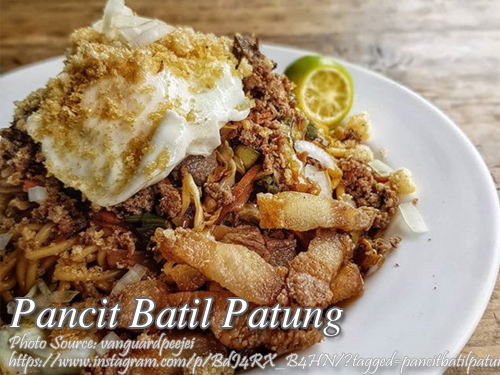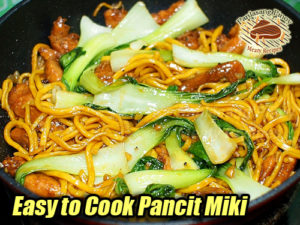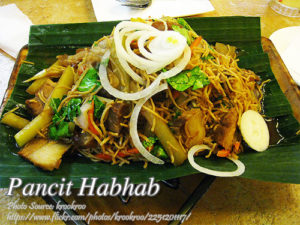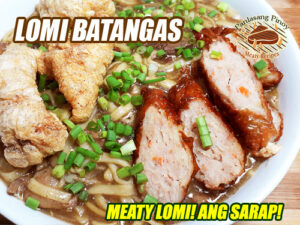I can say that pancit is one of the most popular noodle dish for Pinoys because there are many version of this stir-fried noodles depending on the region of the country. Perhaps the indigenous ingredients used in making their version and the creativity that is why there are variations. But actually we just inherited this dish from the Chinese immigrants who landed in this country centuries ago.
Like for example this pancit batil patung, a specialty of Tuguegarao City, which is made from minced carabeef, miki noodles, bean sprouts, cabbage and some garnishing of crushed pork cracklings and fried eggs. Carabao meat is one of the distinct ingredients used because it is more accessible there compared to cow meat. But since carabeef is not readily available, you can use beef instead.
The Soulful Story Behind The Name and Toppings
It is also served with a soup made from broth (probably carabeef broth) and beaten egg which is why it is called “batil or binatil” meaning to “beat the egg”. And the term “patung” meaning “to put on top”, which in this case topped with minced beef, vegetables, pork cracklings and eggs. If you want to taste the authentic pancit batil patung and to feel the ambiance, you have to go to Tuguegarao City which is very far northern part of Luzon. Just look at the Google map and you will see. But there is no need to go there because you can cook this dish in your own kitchen. In this recipe there is no recipe of the beef broth with the beaten egg so I think I just put it later if you will make a request by making a comment below.
Exploring the Rich History of This Pancit
Pancit, a beloved stir-fried noodle dish, holds a special place in Filipino cuisine. It boasts numerous regional variations, each with its unique flavors and ingredients. Among these is Pancit batil patung, a specialty hailing from the vibrant city of Tuguegarao. This dish is a testament to the Filipino’s ingenuity in adapting and enriching culinary traditions.
The Origins of Pancit
Pancit’s origins can be traced back to Chinese immigrants who settled in the Philippines centuries ago. They brought with them noodle-making techniques and flavor profiles that blended seamlessly with local ingredients and cooking styles. This cultural fusion gave birth to the diverse array of pancit dishes we enjoy today.
The Unique Flavors of Tuguegarao’s Pancit
Pancit batil patung stands out for its use of indigenous ingredients and distinct cooking methods. One of its key components is carabeef, the meat of the water buffalo, which is more readily available in Tuguegarao compared to cow meat. The use of carabeef lends a rich, savory flavor to the dish, setting it apart from other pancit varieties.
Cooking the Pancit: A Culinary Adventure
To prepare the pancit, start by sautéing ground beef in a pan until browned. Set it aside and sauté garlic, onion, and cabbage until fragrant. Add fish sauce and pepper for seasoning. In the same pan, stir-fry pork belly until browned, then set aside.
Next, sauté the remaining garlic and onions until fragrant. Stir in miki noodles, chicken stock, and soy sauce, cooking for about 5 minutes. Add bean sprouts and season with patis.
A Taste of Tuguegarao
To serve, place the noodles on a platter and top them with the cooked vegetables. Spread the ground beef over the vegetables, followed by crushed chicharon. Top it off with fried eggs for a hearty and satisfying meal.
Final Thoughts
Pancit batil patung is more than just a dish; it’s a testament to the rich culinary heritage of the Philippines. Its unique flavors and cooking techniques reflect the country’s diverse cultural influences. So, the next time you’re craving a taste of Tuguegarao, why not try your hand at cooking it in your own kitchen? It’s a delicious way to experience a piece of Filipino culture and history.
How to Cook Pancit Batil Patung
Ingredients
- 1/2 kilo fresh miki
- 1/4 kilo pork belly fat sliced into small pieces
- 1/4 kilo ground carabeef or beef
- 1 to 2 cups pork chicharon pork cracklings, crushed
- 200 grams cabbage chopped
- 1 cup bean sprouts
- 3 cups chicken stock
- 1/2 cup soy sauce
- fish sauce to taste
- 2 medium size onion chopped
- 1 head garlic minced
- Freshly ground black pepper
- fried eggs sunny side-up
- cooking oil
- calamansi
Instructions
How to cook Pancit Batil Patung:
- In a pan, heat about a a tablespoon of oil in high heat and saute the ground beef until. Season with salt and remove from the an and set aside.
- In the same pan, heat some oil and saute half of the garlic and onion until fragrant. Add the cabbage and saute until the cabbage is half cooked, about 2 minutes then season with fish sauce and pepper.
- In the same pan, heat the pan in high heat and stir fry the pork belly until brown and some of the fat is rendered. Set aside.
- In the same pan, saute the remaining half of the garlic and onions until fragrant. Increase the heat to high and add the noodles, a cup of chicken stock and sou sauce then stir.
- Then add the remaining chicken stock and stir for at least 5 minutes. Stir in bean sprouts and season with patis.
- To assemble the pancit; put the noodles in a serving platter. Top with the cooked vegetables and spread the ground beef on top of the vegetables. Spread the crushed chicharon on top of the ground beef. Then top with fried eggs. Serve with calamansi and patis for the condiments.
Notes
Cooking Tips:
1. Perfecting the Noodles For optimal texture, blanch the miki noodles in boiling water for just a few seconds before adding them to the stir-fry. This brief cooking time keeps them from becoming mushy and ensures they absorb the flavors of the dish without being overcooked. 2. Building Layers of Flavor To enhance the savory profile of the dish, consider marinating the minced carabeef in soy sauce, calamansi juice, and garlic for at least 30 minutes before cooking. This step infuses the meat with additional depth and richness, elevating the overall taste of the noodle dish. 3. Achieving the Perfect Egg Topping For a visually appealing and delicious finishing touch, fry the eggs sunny-side-up with the yolks still slightly runny. The velvety yolk adds a creamy texture to the dish, blending beautifully with the other ingredients and enhancing its overall appeal.





